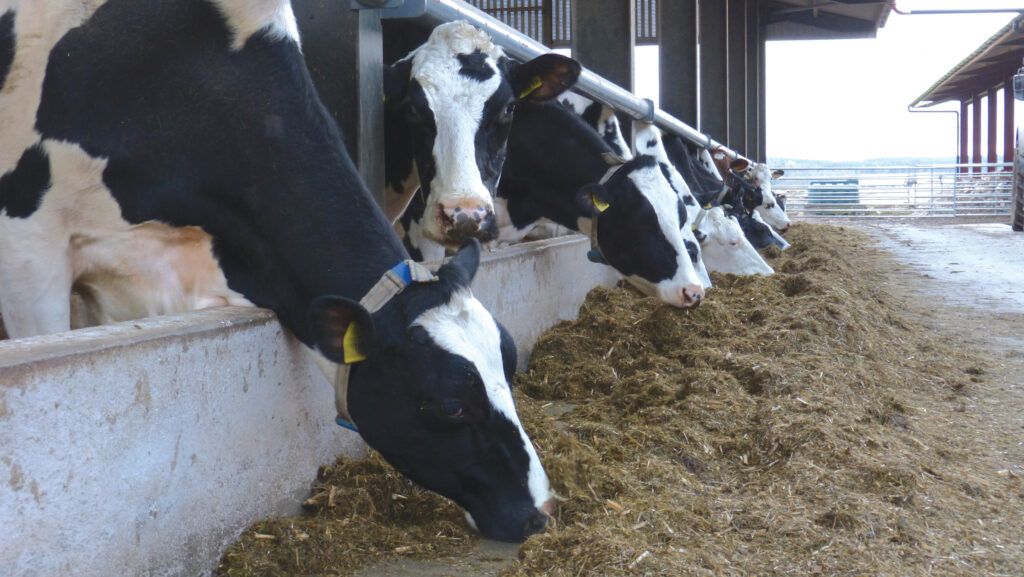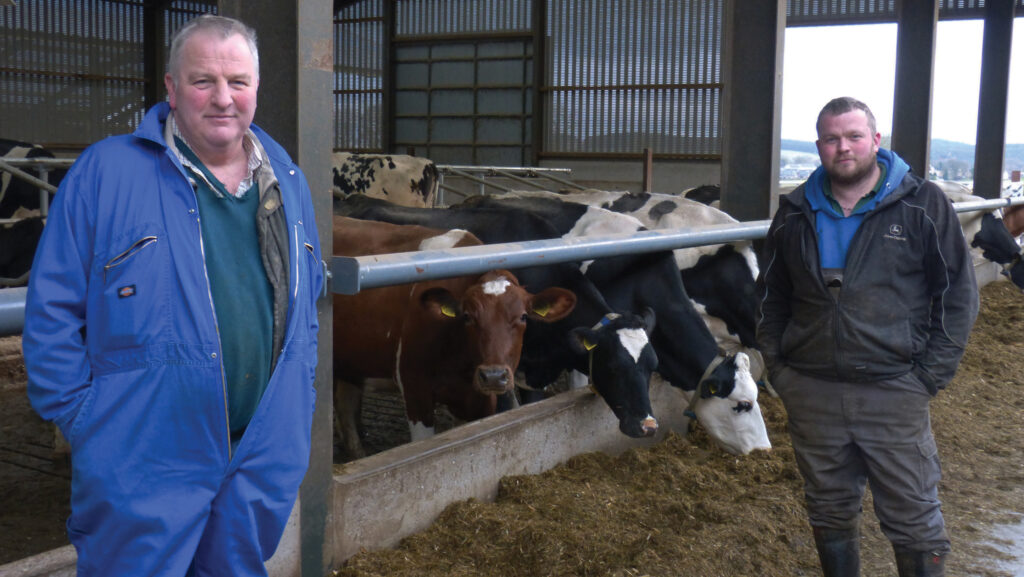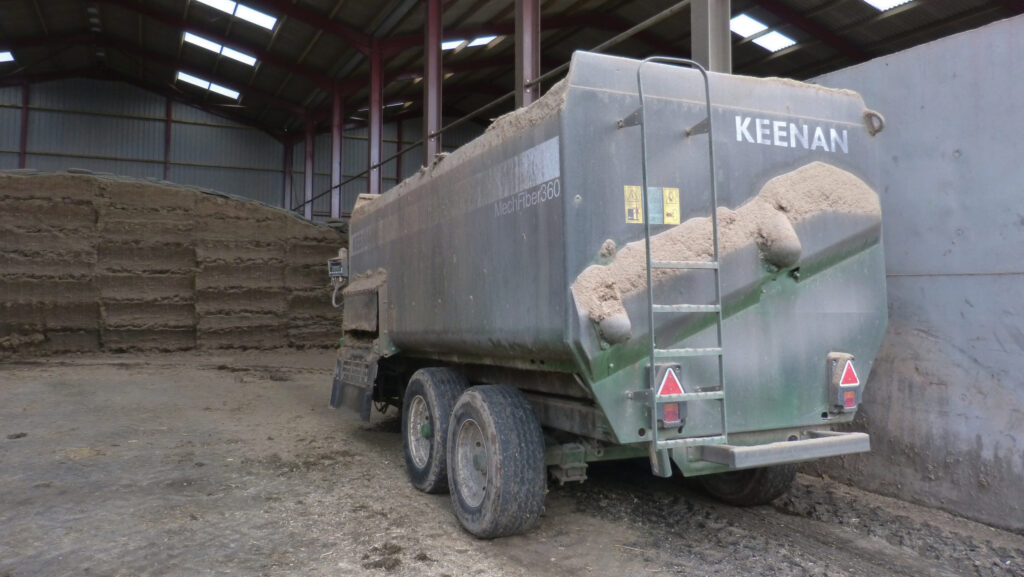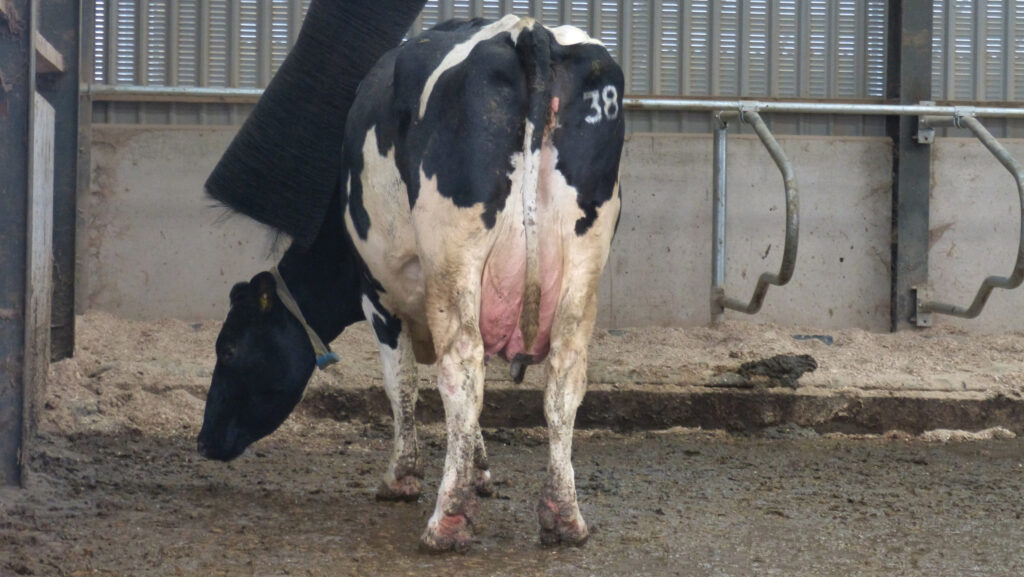Four ways tenant dairy unit manages consistent feeding
 © MAG/Michael Priestley
© MAG/Michael Priestley Adding maize and an alkaline fibre nut to the feed ration has helped a Cumbrian farm maintain rumen health through a period of challenging production years.
Andrew Barraclough took on Gatelands Farm on the Crossrigg Estate, near Penrith, with a farm business tenancy in 1998, when the farm had facilities for 40 milking cows on 64ha (158 acres). Additional land became available in 2001, taking the farm to 122ha (301 acres), half of which was arable at the time.
Today, the farm milks close to 200 cows, keeps all heifer rearing, beef cattle and machinery work in-house, and supports two families, since Andrew and his wife, Ange, became grandparents.
See also: 6 ways to check feed intakes for high-yielding cows
A consistent diet is vital to rumen stability for the housed herd, which calves year round with an autumn bias, explains Andrew. Only youngstock and dry cows graze, while the milking herd gets a ration based on grass silage, maize silage, wholecrop cereal and crimped barley.
Farmers Weekly asked the Barracloughs how they have managed their system through increasingly turbulent weather patterns and challenges to expansion caused by competitive rental values.
Farm facts
Gatelands Farm, Penrith, Cumbria
- 190 cows in milk at peak production
- Holstein-Friesian herd with some Fleckviehs
- Lactation average 9,500 litres at 4.4% fat and 3.4% protein
- 122ha rented from Crossrigg Estate
- Growing 12ha maize, 10ha winter wheat for wholecrop and 14ha spring barley for wholecrop and grain
- Bull calves finished at eight months for premium veal
- Milk sold to Arla
1. Machinery sharing
A good working relationship with a trustworthy dairy-farming neighbour has allowed the Barracloughs to share machinery, staying in control of cropping and cultivation operations.
The arrangement dates to 2007, when the two businesses went halves on a grain crimper. A forage harvester, sprayer, umbilical system and digger are also shared.
“We have our own combine harvester, drills and ploughs, but just about everything else is shared,” explains Andrew. “There is nothing in writing, it’s just based on trust and being good neighbours, and we don’t even keep count of hours of use – it evens itself out in the end.”
The Barracloughs take four cuts of grass silage, starting from 15-20 May. The key benefit is avoiding the lottery of contractor queues, and getting silage cut and clamped whenever weather windows appear.
“There are some great contractors in our area, but it benefits us to get on when we want to,” explains Andrew. “Cutting and tedding and clamping grass really matters in terms of keeping quality in the forage.”
A covered forage feed store was completed in 2024 to help with consistent fermentations and clamp management, with one shed each for wholecrop, grass silage and maize silage. Each clamp is 3.65m high, 15.26m across and built with funding via the Countryside Stewardship Mid Tier scheme. Two sheds span six bays each, while the third has seven.

Andrew Barraclough (left) and son James © MAG/Michael Priestley
2. Standard operating procedures
Andrew, Ange and their son James run the farm and employ three part-time staff. James’s partner, Helen, makes the herd breeding decisions.
Andrew is also a North Lakes district Arla representative. This role takes him off-farm one or two days a month and into the house for weekly online meetings, meaning feeding duties are regularly delegated.
Andrew, James, and staff member Tom Barker are all trained in mixing the feed and feeding the cows, and the same protocol is followed whoever is feeding. Two diets are fed (milking cows, and dry cows and heifers). Parlour cake is fed to yield, and the total mixed ration is calculated to meet maintenance plus 24-26kg of milk.
Ration ingredients are put in the mixer wagon in the same order: straights, chopped straw and half the maize. The mixing then starts, after which bulky forages like wholecrop and grass silage are added. The ration is chopped to a 16-17mm length.
Shed layout means automatic feed pushers are not practical, so push-ups are done with a tyre pusher on the load-all twice a day, between morning milking when cows are fed, and afternoon milking.
“We try and ensure consistency in how we mix the feed, and how it looks every day. If cows get regular feeding, it supports rumen health, which is important as we are always being told what a cost subacute rumen acidosis is to dairy herds.”

© MAG/Michael Priestley
3. Diversified cropping
With annual rainfall of 1,000-1,500mm, conditions for cutting grass and harvesting on the farm’s heavy clay loams can be challenging. The Barracloughs re-evaluated their options in 2023, when wet, clashy weather left the farm with a surfeit of acidic, low dry-matter grass silage.
Andrew sought agronomy advice and opted to grow maize as a hedge against increasingly variable weather. Already benefiting from a flexible approach to using cereals, by wholecropping or combining to crimp early at an 18% moisture level, he decided to grow the crop under film to spread risk. He reasoned he would have a crop to harvest in October if the summer was challenging.
Describing it as a “baptism of fire”, with a cold, late, wet spring and very little summer sunshine, the farm’s first maize growing year of 2024 produced a moderate yield of 29t/ha, getting 400t from 13ha (32 acres).

© MAG/Michael Priestley
4. Buffering acidic forages
The Barracloughs started feeding an alkaline pelleted feed in 2023 after a wet summer left field conditions too poor to take a final cut. About 9kg of grass silage a cow a day was replaced by 3kg of pellet, lifting the farm’s bought-in feed rate from 0.41kg/litre to 0.43kg/litre.
Their nutritional adviser, Debby Brown of Dugdale Nutrition, said the Alkafibre product, with a pH of 9, would help rumen stability and work as a forage extender. It also compared favourably with other options (see “Cost comparison of bought-in feeds in 2024”).
Costing 81p a cow a day, the pellet lifted daily yield by 1.9 litres and helped milk protein content recover from 3.28% to the farm’s typical 3.4%. Debby calculates a cost of 6.78p/litre for all bought-in feed and a margin over purchased feed of 26.6p/litre.
Cost comparison of feeds in 2024 |
|||||
|
Feed |
Cost £/t dry matter |
Metabolisable energy (MJ/kg dry matter) |
Crude protein % dry matter |
Cost p/MJ ME |
Cost p/% CP |
|
Alkaline pellet |
270 |
12.2 |
15.7 |
2.21 |
1.72 |
|
Brewers’ grains |
312 |
11.7 |
24.5 |
2.67 |
1.27 |
|
Grass silage |
184 |
11.1 |
16.5 |
1.66 |
1.12 |
And while Andrew would like to cut feed costs by growing more forage, he says that, with land at £240/acre in the district, reliable bought-in feeds are welcome.
“Taking on rented land is often costly and inconvenient. We can guarantee that the feed coming in on the wagon is consistent, which we can’t do with our forages, so we have left 3kg of alkaline pellets in the ration this year, although 2024 was a better silage year for us.”
